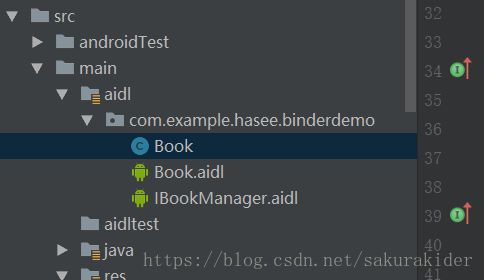安卓IPC机制(二)---Binder的工作机制
吐槽
中午起床后晕乎乎的,还是自己下午看书学东西,晚上写项目吧
Binder的理解
发现这个感觉真的是现在给我看好复杂啊,,,然后还是先了解下吧,以后自己看的时候会好受一点。
- 直观的说Binder是Android的一个类,它实现IBinder接口
- 从IPC的角度来看,Binder是一种跨进程通信的方式
- Binder还可以理解为一种虚拟的物理设备,它的驱动是/dev/binder
- 从Android Framework的角度讲,Binder是ServiceManager连接各种Manager和ManagerService的桥梁
- 从Android应用层来讲的话,Binder是客户端和服务端进行通信的媒介
建立一个AIDLDemo
先重新建个包
准备3个东西Book.java,Book.aidl和IBookMangager.aidi

先是Book.java 继承 parcelable
public class Book implements Parcelable {
public int bookId;
public String bookName;
public Book(int bookId,String bookName){
this.bookId = bookId;
this.bookName = bookName;
}
protected Book(Parcel in) {
bookId = in.readInt();
bookName = in.readString();
}
public static final Creator CREATOR = new Creator() {
@Override
public Book createFromParcel(Parcel in) {
return new Book(in);
}
@Override
public Book[] newArray(int size) {
return new Book[size];
}
};
@Override
public int describeContents() {
return 0;
}
@Override
public void writeToParcel(Parcel dest, int flags) {
dest.writeInt(bookId);
dest.writeString(bookName);
}
} 然后是Book.aidl
package com.example.hasee.binderdemo;
parcelable Book;
最后是IBookManager.aidl
实现了两个方法,getBookList 和addBook
尽管Book类和IBookManager位于同一个包下,但是还是要导入Book类
package com.example.hasee.binderdemo;
import com.example.hasee.binderdemo.Book;
interface IBookManager {
List getBookList();
void addBook(int Book );
}
然后,你会发现按照书上这么写,,,会报错,找不到Book类
解决方法就是在app下的gradle里面android{}里面加入一段代码
sourceSets {
main {
manifest.srcFile 'src/main/AndroidManifest.xml'
java.srcDirs = ['src/main/java', 'src/main/aidl']
resources.srcDirs = ['src/main/java', 'src/main/aidl']
aidl.srcDirs = ['src/main/aidl']
res.srcDirs = ['src/main/res']
assets.srcDirs = ['src/main/assets']
}
}然后就好了
最后结果发行是好的情况是在
发现这块自动生成的一个IBookManager类

package com.example.hasee.binderdemo;
public interface IBookManager extends android.os.IInterface
{
/** Local-side IPC implementation stub class. */
public static abstract class Stub extends android.os.Binder implements com.example.hasee.binderdemo.IBookManager
{
private static final java.lang.String DESCRIPTOR = "com.example.hasee.binderdemo.IBookManager";
/** Construct the stub at attach it to the interface. */
public Stub()
{
this.attachInterface(this, DESCRIPTOR);
}
/**
* Cast an IBinder object into an com.example.hasee.binderdemo.IBookManager interface,
* generating a proxy if needed.
*/
public static com.example.hasee.binderdemo.IBookManager asInterface(android.os.IBinder obj)
{
if ((obj==null)) {
return null;
}
android.os.IInterface iin = obj.queryLocalInterface(DESCRIPTOR);
if (((iin!=null)&&(iin instanceof com.example.hasee.binderdemo.IBookManager))) {
return ((com.example.hasee.binderdemo.IBookManager)iin);
}
return new com.example.hasee.binderdemo.IBookManager.Stub.Proxy(obj);
}
@Override public android.os.IBinder asBinder()
{
return this;
}
@Override public boolean onTransact(int code, android.os.Parcel data, android.os.Parcel reply, int flags) throws android.os.RemoteException
{
switch (code)
{
case INTERFACE_TRANSACTION:
{
reply.writeString(DESCRIPTOR);
return true;
}
case TRANSACTION_getBookList:
{
data.enforceInterface(DESCRIPTOR);
java.util.List _result = this.getBookList();
reply.writeNoException();
reply.writeTypedList(_result);
return true;
}
case TRANSACTION_addBook:
{
data.enforceInterface(DESCRIPTOR);
int _arg0;
_arg0 = data.readInt();
this.addBook(_arg0);
reply.writeNoException();
return true;
}
}
return super.onTransact(code, data, reply, flags);
}
private static class Proxy implements com.example.hasee.binderdemo.IBookManager
{
private android.os.IBinder mRemote;
Proxy(android.os.IBinder remote)
{
mRemote = remote;
}
@Override public android.os.IBinder asBinder()
{
return mRemote;
}
public java.lang.String getInterfaceDescriptor()
{
return DESCRIPTOR;
}
@Override public java.util.List getBookList() throws android.os.RemoteException
{
android.os.Parcel _data = android.os.Parcel.obtain();
android.os.Parcel _reply = android.os.Parcel.obtain();
java.util.List _result;
try {
_data.writeInterfaceToken(DESCRIPTOR);
mRemote.transact(Stub.TRANSACTION_getBookList, _data, _reply, 0);
_reply.readException();
_result = _reply.createTypedArrayList(com.example.hasee.binderdemo.Book.CREATOR);
}
finally {
_reply.recycle();
_data.recycle();
}
return _result;
}
@Override public void addBook(int Book) throws android.os.RemoteException
{
android.os.Parcel _data = android.os.Parcel.obtain();
android.os.Parcel _reply = android.os.Parcel.obtain();
try {
_data.writeInterfaceToken(DESCRIPTOR);
_data.writeInt(Book);
mRemote.transact(Stub.TRANSACTION_addBook, _data, _reply, 0);
_reply.readException();
}
finally {
_reply.recycle();
_data.recycle();
}
}
}
static final int TRANSACTION_getBookList = (android.os.IBinder.FIRST_CALL_TRANSACTION + 0);
static final int TRANSACTION_addBook = (android.os.IBinder.FIRST_CALL_TRANSACTION + 1);
}
public java.util.List getBookList() throws android.os.RemoteException;
public void addBook(int Book) throws android.os.RemoteException;
} 看的我一脸懵逼,,,,不知道这个是什么鬼
然后继续看书上的解释
上述代码是系统生成的,在gen目录下,可以看到根据IBookManager.aidl系统为我们生成了IBookManager.java这个类,它继承了IInterface这个接口,同时它自己也还是个接口,所有可以在Binder中传输的接口都需要继承IInterface接口。这个类刚开始看起来逻辑混乱,但是实际上还是很清晰的,通过它我们可以清除地了解到Binder的工作机制。这个类的结构其实很简单,首先它声明了两个方法getBookList()和addBook(),显然这就是我们在IBookManager.aidl中所声明的方法,同时它还声明了两个整型的id分别用于标识这两个方法,这两个id用于标识在transact过程中客户端所请求的到底是哪个方法。接着,它声明了一个内部类Stub,这个Stub就是一个Binder类,当客户端和服务端都位于同一个进程时,方法调用不会走跨进程的transact过程,而当两者位于不同进程时,方法调用需要走transact过程,这个逻辑由Stub的内部代理类Proxy来完成。这么来看,IBookManager这个接口的确很简单,但是我们也应该认识到,这个接口的核心实现就是它的内部类Stub和Stub的内部代理类Proxy。
里面的方法和重要的属性
DESCRIPTOR
Binder的唯一标识,一般用当前Binder的类名表示。
asInterface (android.os.IBinder obj)
用于将服务端的Binder对象转换成客户端所需的AIDL接口类型的对象,这种转换过程是区分进程的,如果客户端和服务端位于同一进程,那么此方法返回的就是服务端的Stub对象本身,否则返回的是系统封装后的Stub.proxy对象
asBinder()
此方法用于返回当前Binder对象
onTransact
这个方法运行在服务端中的Binder线程池中,当客户端发起跨进程请求时,远程请求会通过系统底层封装后交由此方法处理。该方法的原型为 public boolean onTransact(int code, android.os.Parcel data, android.os.Parcel reply, int flags) 。服务端通过code可以确定客户端所请求的目标方法是什么,接着从data中取出目标方法所需的参数(如果目标方法有参数的话),然后执行目标方法。当目标方法执行完毕后,就向reply中写入返回值(如果目标方法有返回值的话),onTransact方法的执行过程就是这样的。需要注意的是,如果此方法返回false,那么客户端的请求会失败,因此我们可以利用这个特性来做权限验证,毕竟我们也不希望随便一个进程都能远程调用我们的服务。
Proxy#getBookList
这个方法运行在客户端,当客户端远程调用此方法时,它的内部实现是这样的:首先创建该方法所需要的输入型Parcel对象_data,输出型Parcel对象_reply和返回值对象List;然后把该方法的参数信息写入_data中(如果有参数的话);接着调用transact方法来发起RPC(远程过程调用)请求,同时当前线程挂起;然后服务端的onTransact方法会被调用,直到RPC过程返回后,当前线程继续执行,并从_reply中取出RPC过程的返回结果;最后返回_reply中的数据。
Proxy#addBook
这个方法运行在客户端,它的执行过程和getBookList是一样的,addBook没有返回值,所以它不需要从_reply中取出返回值。
通过上面的分析,读者应该已经了解了Binder的工作机制,但是有两点还是需要额外说明一下,首先,当客户端发起远程请求时,由于当前线程会被挂起直至服务端进程返回数据,所以如果一个远程方法是很耗时的,那么不能在UI线程中发起此远程请求,其次,由于服务端的Binder方法运行在Binder的线程池中,所以Binder方法不管是否耗时都应该采用同步的方式去实现,因为它已经运行在一个线程中了。为了更好地说明Binder,下面给出一个Binder的工作机制图。
注意点与总结
- 远程请求是耗时的。客户端发起请求时,当前线程会被挂起直到服务端返回数据,所以不能再UI线程进行远程请求
- 服务端的onTransact()运行在Binder线程池中,所以此Binder方法是否耗时,都应该采用同步方式去实现,因为它已经运行在一个单独线程中了。
- 如果因为某些原因,服务端进程异常终止,如果我们不知道连接已经断裂,那么客户端就会受到影响。应该通过Binder的linkToDeath和unlinkToDeath设置死亡代理。
自定义Binder类
这个实在是看不懂了,先留着这里
- 声明一个AIDL的接口
- 实现Stub类和Stunb类的Proxy代理类
- DeathRecipient对象,DeathRecipient是一个接口,其内部只有一个方法binderDied,我们需要实现这个方法,当Binder死亡的时候,系统就会回调binderDied方法,然后我们就可以移出之前绑定的binder代理并重新绑定远程服务
总结
自己还是好好写项目吧,真的是看书看的煎熬啊啊啊啊
